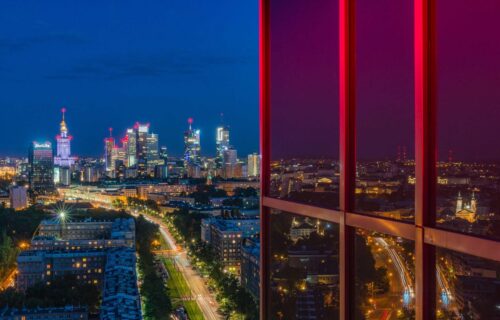Light, both natural and artificial, has a significant impact on life on Earth. Over millions of years, all living organisms have adapted to the natural rhythm of day and night, governed by sunlight and its variations in intensity. For humans, natural light influences essential processes such as the production of melatonin and serotonin, which regulate sleep, mood, and energy levels. In plants, sunlight drives photosynthesis and seasonal growth, while animals adjust behaviors like migration, reproduction, and hunting to changes in daylight.
However, artificial light can disrupt these natural cycles. Light pollution, caused by excessive or misdirected artificial lighting, has emerged as a growing environmental concern. Unlike air or water pollution, it often goes unnoticed, but its consequences are significant, affecting ecosystems, human health, and astronomical observations.
Magdalena Oksańska of Savills Poland emphasizes that responsible lighting design in real estate has become an essential component of environmental stewardship, impacting both human well-being and the broader ecosystem.
Light pollution commonly originates from streetlights, neon signs, illuminated advertisements, and buildings that remain lit throughout the night. Instead of targeting specific areas, light often spills into unintended spaces such as green areas, water bodies, building façades, and the night sky. This misdirected light disrupts wildlife that relies on darkness for navigation, reproduction, and survival. For instance, migratory birds can become disoriented by bright lights, leading to collisions with buildings, while insects drawn to artificial lights often perish from exhaustion or become easy prey, contributing to declining populations.
Other species, including bats and sea turtles, also face challenges due to artificial light. Bats avoid lit areas where they are more vulnerable to predators, affecting their feeding and breeding habits. Sea turtle hatchlings, guided naturally by moonlight, sometimes crawl toward artificial coastal lights instead of the ocean, significantly reducing their survival rates. Plants are not immune either; artificial lighting can interfere with flowering, dormancy, and relationships with pollinators, thereby impacting broader food chains.
Artificial light also affects human health by disturbing circadian rhythms. The widespread presence of blue light from screens and LEDs suppresses melatonin production, resulting in shorter and poorer-quality sleep. In urban areas, the night sky is so bright that many residents rarely experience natural darkness. Reports indicate that up to 80 percent of the world’s population and 99 percent of people in Europe and North America cannot see the Milky Way from where they live.
The phenomenon was illustrated in 2003 during a massive blackout in the United States, when millions of people in New York City, many for the first time, saw the stars clearly—a sight that initially caused confusion and awe. In Poland, about 60 percent of the population lacks the opportunity to view the Milky Way due to urban light pollution.
Recent reports highlight the increasing severity of light pollution in Poland. The Light Pollution Think Tank (LPTT), in collaboration with the Space Research Centre of the Polish Academy of Sciences, found that in 2022, the intensity of light emitted into the sky was at its highest level ever recorded, six percent above the average for the previous decade. Urban areas can be several thousand times brighter than natural levels, with cities like Warsaw, Kraków, Wrocław, Łódź, and Poznań being the brightest. Notably, some areas in Warsaw never experience true night conditions due to constant illumination.
Despite growing awareness, Poland currently lacks legal frameworks that define or regulate light pollution as an environmental threat. Existing guidelines are non-binding, and there is no systematic government monitoring of the issue.
There have been efforts to protect dark skies in Poland, including the creation of Dark Sky Parks in the Bieszczady and Izery Mountains, where artificial lighting is limited to preserve natural darkness. Some municipalities have also implemented practices like switching off street lights at night to reduce light pollution, benefiting both wildlife and astronomical observation.
In the real estate sector, improper lighting design contributes significantly to light pollution. Many commercial properties are illuminated beyond necessity, with lights spilling into unused spaces or directed upward, wasting energy and affecting the surrounding environment. Neon signs and building façades often remain lit throughout the night, although the pandemic demonstrated that reduced lighting during off-hours is feasible without significant economic impact.
Warehouse developments, in particular, require careful lighting strategies, as poorly directed lights can illuminate fields, wetlands, and protected natural areas unnecessarily. However, examples exist of industrial sites implementing better solutions, directing light downward where needed and using warmer color temperatures to minimize ecological disruption. Products that meet DarkSky Approved standards are now available, promoting lighting designs that limit upward light emissions and reduce overall brightness.
The LPTT report recommends that the real estate industry adopt sustainable lighting practices, using modern technologies and thoughtful design to minimize the impact of artificial light on the environment. Light pollution continues to grow globally, with estimates suggesting an annual increase of at least two percent. While technological progress has brought convenience, it also carries unintended consequences for ecosystems.
Like the early warnings about climate change and plastic pollution, light pollution requires recognition as a genuine environmental challenge. Its effects, though often invisible, are profound and far-reaching. Protecting natural darkness is essential for the health of ecosystems, human well-being, and the preservation of the cultural and scientific value of the night sky.
Sources: Savills Polska, Eklöf, J. (2024). Manifesto of Darkness. Warsaw: Wydawnictwo Krytyki Politycznej,
Szlachetko, K. (ed.). (2025). Towards Sustainable Outdoor Lighting. An Interdisciplinary Study. Gdańsk: Gdańsk University Press and Light Pollution Think Tank. (2023). Light pollution in Poland. Report 2023 (A. Z. Kotarba, ed.). Warsaw: Space Research Centre of the Polish Academy of Sciences Publishing House.
